The Athabasca Glacier is one of the most incredible sites along the Icefields Parkway. Whenever we make the journey from Banff to Jasper, we stop there. You can’t drive past it without stopping. It’s a rule in our family. No matter how many times I have seen it, this enormous glacier never ceases to amaze me. Last September, my husband and I decided it was time to get a bird’s eye view of the glacier and the surrounding mountains on the Wilcox Pass hike. This phenomenal day hike has the best views of the Athabasca Glacier we’ve ever seen. When we sat in the red chairs, we didn’t want to move. The view before us was just that beautiful.
There are affiliate links in this post. If you make a qualifying purchase through one of these links, Wander Woman Travel Magazine may receive a small commission at no extra cost to you. Thanks for your support!
Table of Contents
A Little History About Wilcox Pass
Mount Wilcox (2884 m) and the pass that provides access to it (Wilcox Pass) were named by J. Norman Collie in 1899. They were named after Walter D. Wilcox, an early explorer and mountaineer in the Canadian Rockies. Wilcox made the first ascent of the peak that bears his name in 1896. He is also credited with the discovery and exploration of Paradise Valley, Desolation Valley and Prospector Valley near Lake Louise. Walter Wilcox made the first ascents of a number of other Rocky Mountain Peaks including Mount Aberdeen (3,152m), Mount Niblock (2,976m), Mount Indefatigable (2,670m), and Cheops Mountain (2581m). Mount Wilcox is located in Jasper National Park beside the Columbia Icefield Glacier Discovery Centre. The Icefields Parkway traverses the western base of the mountain. Wilcox Pass has been used for thousands of years by Indigenous people who traveled through this region. Traversing the pass allowed early travelers to avoid an impassable canyon on the Sunwapta River north of the Athabasca Glacier.
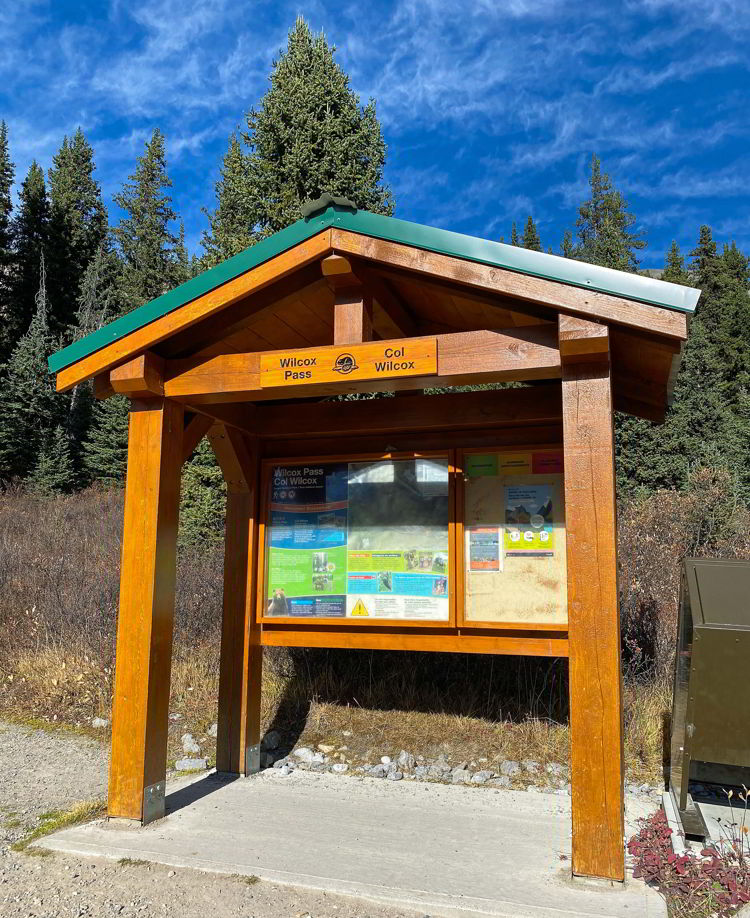
Finding the Wilcox Pass Trailhead
The Wilcox Pass Trailhead is easy to find. It’s located 3.1 km (1.9 mi) south of the Columbia Icefield Glacier Discovery Centre. Look for signs for the Wilcox Creek Campground. You’ll find the parking area for the hike on the left-hand side of the campground area. Be sure to take advantage of the toilets in the parking area. You won’t find any on the trail. There’s also a display sign with information about the hike. Read the information before you start hiking. If there are any bears in the area or other trail updates, they will likely be posted at the trailhead sign.
Wilcox Pass Trail Details
- Trail Rating: Moderate
- Distance: 2.4 km (1.5 mi) return to the first viewpoint (about one hour); 8 km (5 mi) return to the pass (2-3 hours)
- Elevation gain/loss 390 m (1280 ft)
- Altitude of Wilcox Pass: 2350 m (7711 ft)
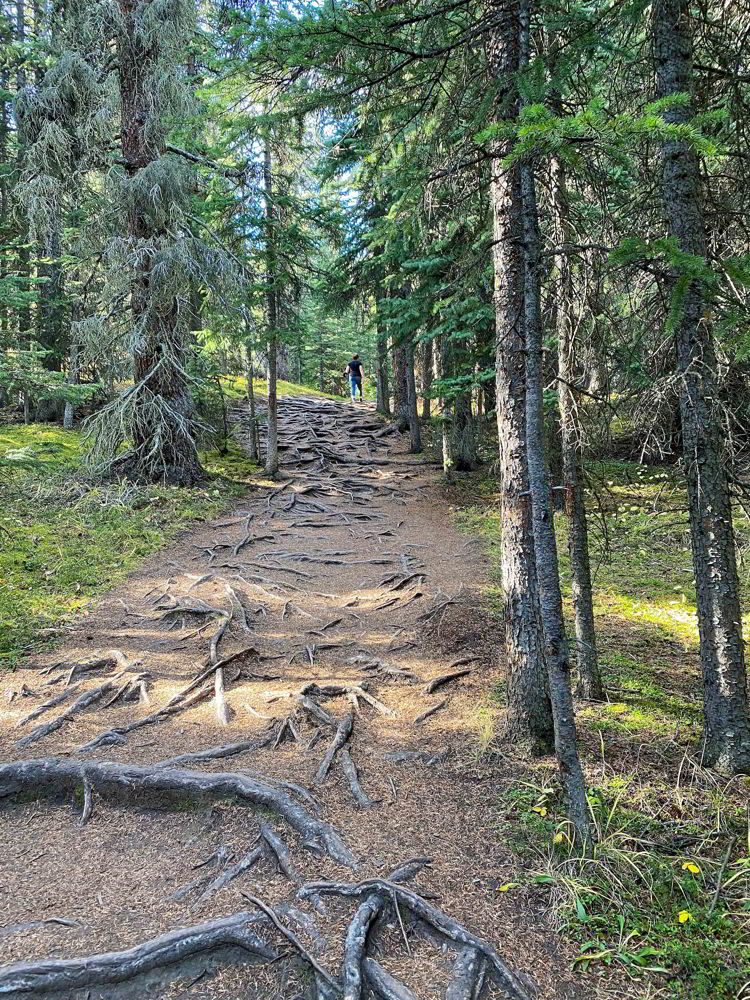
Wilcox Pass Hike Description
The first kilometre of the Wilcox Pass Trail is relatively steep and passes through trees and woods. There are lots of tree roots in some places and the trail itself is a mix of gravel and sand. It gets easier when you get above the tree line and reach the wide open pass area.
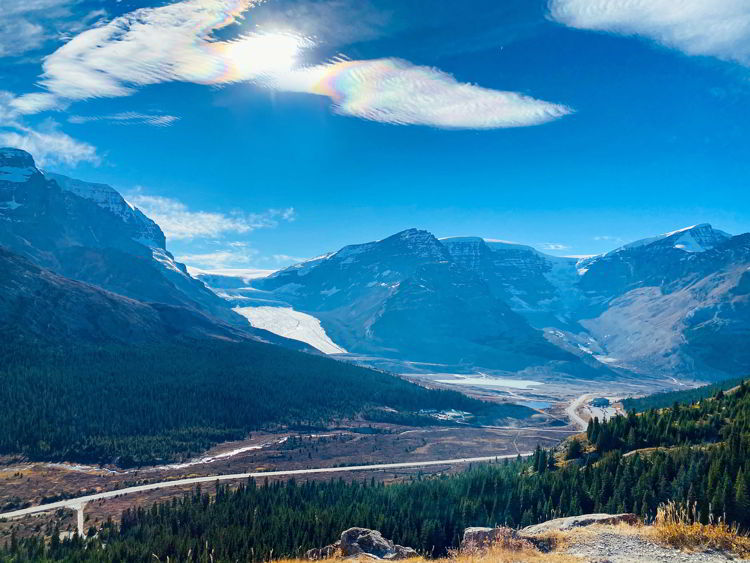
Partway up you’ll find the red chairs. Parks Canada places red chairs in some of the most scenic locations in Canada’s national parks. Be sure to stop and just soak in the view of mountains and ice, but hold onto your hat. It can be quite windy on the exposed ridge by the red chairs. That said, it is one of the prettiest viewpoints in the Canadian Rockies – especially on a blue sky day.
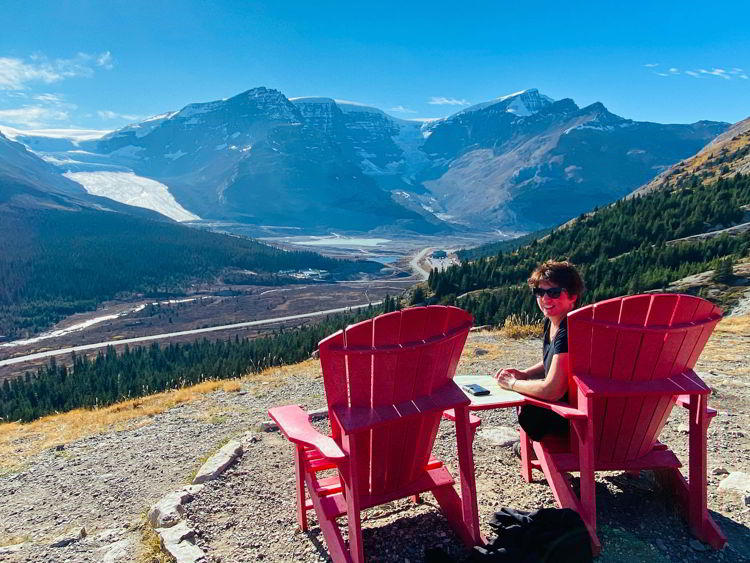
Some people only hike as far as the red chairs, but it’s worth going further if you can. A short steep climb brings you to the alpine meadows around Wilcox Pass. If you’re lucky, you might see bighorn sheep in this area. Before you reach the pass, turn left on the side trail for Wilcox Ridge. The trail climbs to a ridge with wonderful views of the Athabasca Glacier and the mountains and glaciers that make up the eastern edge of the Columbia Icefield. Look for fossils in the rocks, take a break and have a snack, then return back the way you came.
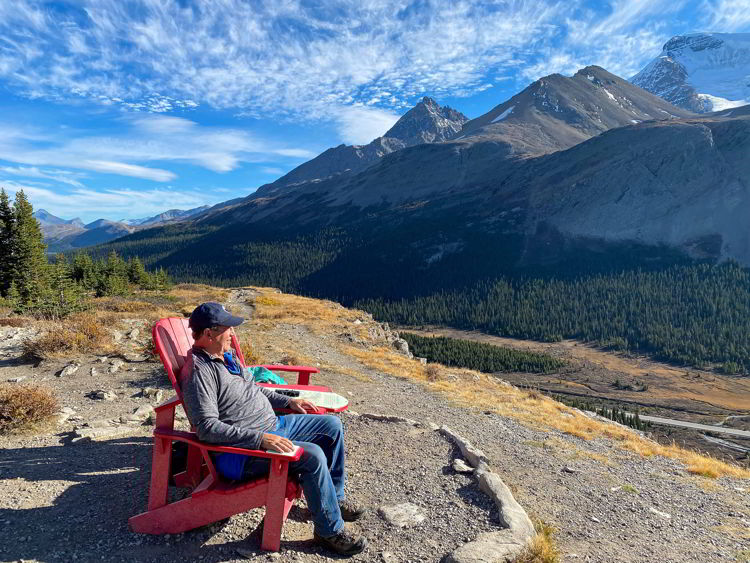
Tips for Hiking Wilcox Pass
Wilcox Pass is a beautiful hike with incredible views of the Athabasca Glacier and the surrounding mountains. Here are a few insider tips to help you have a successful hike.
- Hikers should be aware that the pass area can be snowy into late July.
- Use the bathrooms in the parking lot before you head out on the trail or better yet, use the ones at the Columbia Icefield Glacier Discovery Centre. There are flush toilets inside the centre and outhouses outside it.
- Stay on designated trails to help protect fragile alpine flora near the trail’s edge.
- Practice “Leave no Trace” principles when you’re hiking.
- Gear up before you head out (see below). Weather can change quickly in the Canadian Rockies.
- Look for fossils in the rocks near the summit of Wilcox Pass.
- Watch for Bighorn sheep and other wildlife on this hike, but keep your distance from any wildlife you see.
- Spend some time sitting in the red chairs and soaking in the view!
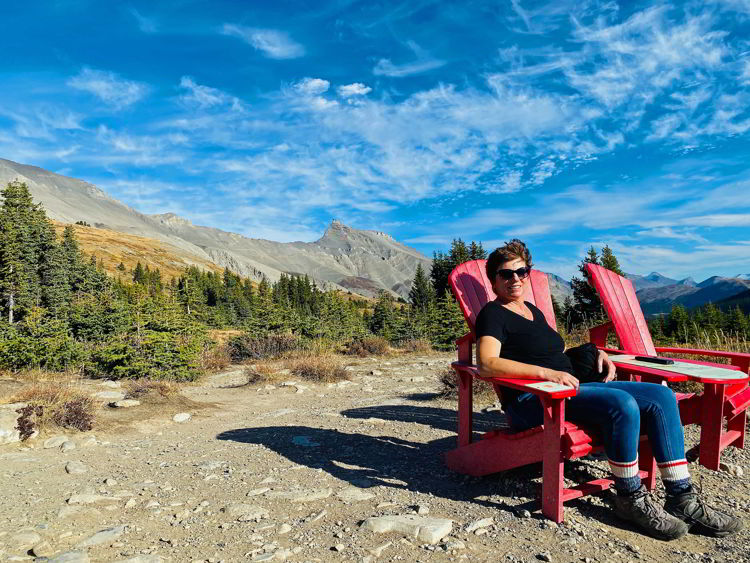
Gear Up for a Great Hike up Wilcox Pass
If you’re doing this hike in the snow, microspikes for hiking can be helpful. The first kilometre of the trail is fairly steep and hiking poles can be helpful in every season. It also gets quite windy near the lookout area, so you should wear layers and bring a wind-proof jacket and gloves in every season. On a sunny day, sunglasses can be useful as well. You’ll need a light daypack to carry water, snacks and extra layers of clothing. You should also carry bear spray when you’re hiking in the Canadian Rockies.
About the Athabasca Glacier and the Columbia Icefield
The Athabasca Glacier is one of the six principle toes of the Columbia Icefield, one of the largest non-polar icefields in the world. The Columbia Icefield covers a staggering 230 square kilometres (89 sq mi). It’s maximum depth is 365 m (1,200 ft) and it is about 28 km (17 mi) long. The icefield sits along the continental divide on the Alberta-BC border. The Athabasca Glacier is visible and accessible from the Icefields Parkway. The Athabasca Glacier is a visible sign of global warming in action. The glacier has lost more than half its volume and receded more than 1.5 km (0.9 mi) in the last 125 years. Look for signs marking the glacier’s recession. Note: It is not safe to hike on the surface of the glacier without a certified guide. There are many hidden crevasses under the ice and several people have died when they have slipped into a crevasse.
Hike to the Toe of the Athabasca Glacier
Another great way to experience the Athabasca Glacier is to hike to the toe of the glacier. Park in the lower parking lot as close as you can get to the glacier. This short one-hour hike is 1.8 km (1.1 mi) return with about 60 m (197 ft) of elevation gain. Wear a jacket, gloves and a warm hat, so you’ll be warm in the glacial wind. Take note of the signs indicating the glacier’s retreat in the last 100 years. Standing on glacially smoothed limestone rock at the base of the glacier is an incredible experience. Scientists believe the Columbia Icefield was formed during the Great Glaciation, or Illinoisan period about 238,000 to 126,000 BC. It’s staggering to think about when you’re gazing out at the glacier.
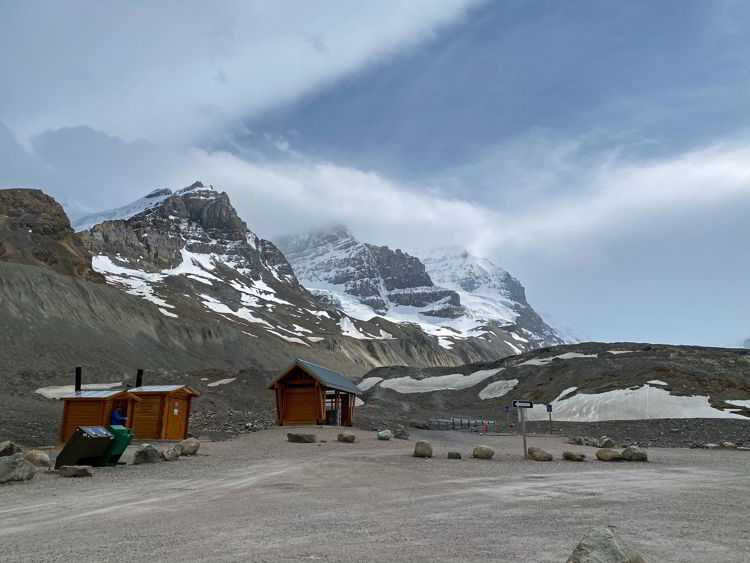
Driving the Icefields Parkway
The Icefields Parkway (Hwy 93) is one of the most beautiful drives on the planet. Along the 233 kilometres (145 mi) between Lake Louise and Jasper, there are more than 100 glaciers. There are also cascading waterfalls, brilliant blue lakes, rugged mountains, abundant wildlife and many excellent hiking trails. You could do the drive in a few hours, but you should plan on taking the better part of a day. You’ll want to pull over often and explore. You’ll find a list of Icefields Parkway hikes on this link on the Parks Canada website.
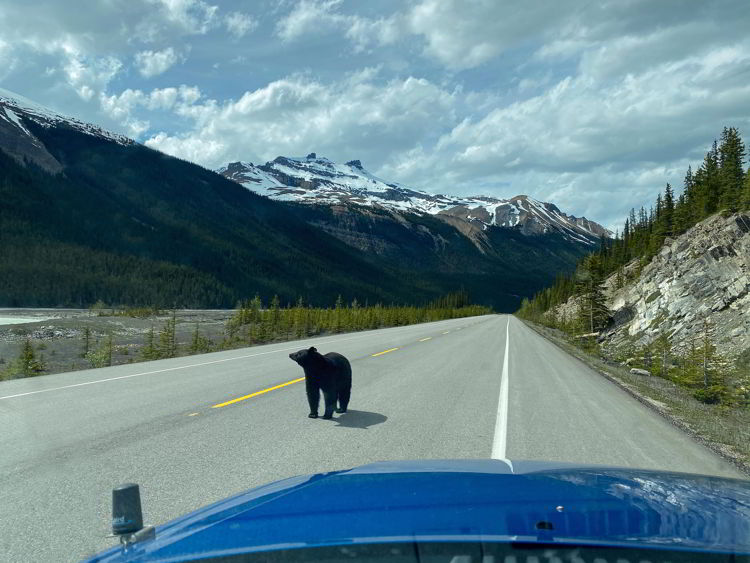
Related: Read our post about Jasper Wildlife Watching to find all the best places to see wildlife in Jasper National Park. (And to see some awesome wildlife photography!)
Where to Stay – Wilcox Pass Hike
The closest campground to the trailhead is the Wilcox Creek Campground. The closest hotel is the Glacier View Lodge, which is located on the upper floors of the Columbia Icefield Discovery Centre. We stayed at the hotel and loved it. The hotel has been completely renovated and is very modern and beautiful. It’s worth paying extra to get a room with a view of the Athabasca Glacier.
Related: Read our post, Jasper Brunch – Best Food and Coffee Restaurants.

No Comments